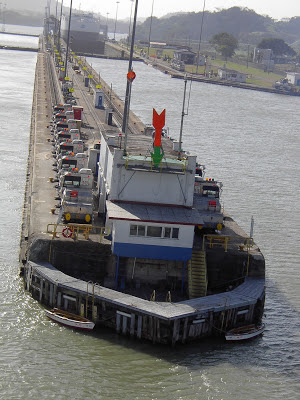I know I threatened you with a trip report. Walk away now if you have something better to do. I won't be offended.
On January 23, we sailed from the port of San Pedro--about a 20-minute taxi ride from the Calcondo. We were headed to the Panama Canal with plans to end up in Ft. Lauderdale on Feb. 6.
After 5 days at sea, we arrived at Puentarenas, Costa Rica--where we shared the pier with the Queen Elizabeth. I was curious to know if she'd fit through the Panama Canal. I never found out. We didn't see her there. But I'm pretty sure she would have had to leave her purse behind.
Here she is, still at the pier, as we sailed away that evening.
After a day at sea, we anchored off of Panama City--just a short ways from the entrance to the canal. We stayed here for a day and a night so passengers could take tours on shore. Mr. Gadget and I, with our slug-like tendencies, stayed glued to our deck chairs.
In fact, we found our air-conditioned stateroom to be the ideal place to watch the canal passage on our flat screen TV.
But we didn't stay there all day. We spent some time in the air-conditioned indoor pool area and watched the passing ships from the comfort of nicely-padded lounge chairs. Here's the Pacific Princess--a sister ship to ours (but considerably smaller)--passing us in the opposite direction. This called for much horn-honking. The woman sitting next to me--with bare feet and an expensive pedicure--was playing games on her iPad.
This huge ship was passing through the canal in the lane next to us. It's a car carrier--known as a roro in the nautical world. The loading process involves lots of rolling on and rolling off.
Here's a good view of a lock gate and the different water levels. This picture was taken from the stern looking behind our ship. We were moving out of the lock after the water level has been raised.
Here's a whole herd of mules--small locomotives that help guide the ships. Each one holds two ropes that are attached to the sides of the ship. There were 4 mules on each side of ours. The ropes are held taut to keep the ship from hitting the sides of the canal. There is, at most, a foot to spare. In spite of modern technology, the ropes are secured as they've been for almost 100 years--with the help of 2 men in a rowboat.
This is the end of the canal on the Atlantic Ocean side. The canal operates day and night, 7 days a week. After dark, the arrow is lighted to alert approaching ships to pass on either the right or the left.
After leaving the canal (the 48-mile distance takes about 8 hours) we had a rough night of sailing to Cartagena, Colombia--the only rough seas of the trip--but fortunately it was during the night. Neither of us fell out of bed. Our 4-course dinner most likely provided extra ballast.
Our final stop was Aruba. There's lots of good shopping there if you're into jewelry and gemstones, but we aren't. We usually just stop in for a local beer and hobnob with the friendly critters--which were in plentiful supply.
So now we're back to real life.....and counting our blessings that we weren't on that other ship. I can't even imagine....












1 comment:
I enjoyed your short and insightful story as I lie back for a short nap while Hubbs takes a short walk in the hood! Very good pictures of the locks and the canal...very interesting. Thanks! loved it!
Post a Comment